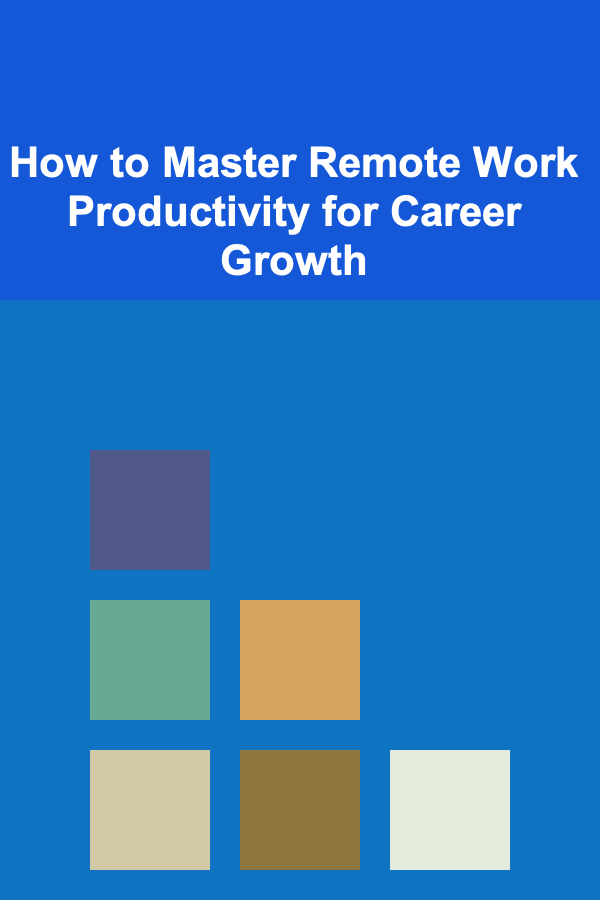
How to Master Remote Work Productivity for Career Growth
ebook include PDF & Audio bundle (Micro Guide)
$12.99$10.99
Limited Time Offer! Order within the next:

Remote work has become a standard practice for millions of workers worldwide. Whether due to technological advancements, shifts in work culture, or the global pandemic that reshaped traditional office environments, remote work is here to stay. However, for many, the transition to working remotely has brought with it unique challenges---chief among them being how to maintain and even improve productivity outside the structured environment of an office. Mastering remote work productivity is not just about keeping up with daily tasks; it's about leveraging your remote work setup to enhance your performance and accelerate your career growth.
In this comprehensive guide, we will explore strategies, tools, and mindsets that can help you master remote work productivity, ensuring that you not only meet but exceed your professional goals while working from home or anywhere else.
Create an Effective Home Office Environment
One of the most important elements of mastering remote work productivity is setting up a productive workspace. Your physical environment plays a crucial role in your ability to concentrate, remain organized, and stay motivated.
a) Find a Dedicated Workspace
The first step is to find a dedicated workspace within your home or wherever you choose to work. It's tempting to work from the couch, bed, or kitchen table, but these spaces are often filled with distractions that can hinder focus. Ideally, your workspace should be separate from areas where you relax or socialize, allowing you to mentally switch between work and personal life.
If you don't have a separate office, carve out a small corner or even a specific table that is exclusively for work. This separation helps condition your mind to enter work mode when you sit down in that space.
b) Optimize Your Setup
Your physical setup plays a huge role in your productivity. Invest in ergonomic furniture, such as a comfortable chair and a desk that fits your needs. Good lighting is also essential---avoid harsh overhead lighting and try using a lamp that shines on your workspace.
Make sure your equipment is efficient and functional. Your computer should have the necessary software, a good internet connection, and any other tools that make your work more efficient. A large monitor, for instance, can boost productivity by giving you more screen space for multitasking.
c) Reduce Distractions
Distractions are one of the biggest hurdles when working remotely. At home, you may be surrounded by laundry, dishes, or other household tasks. To minimize these distractions, try implementing systems such as time-blocking. Allocate specific periods during the day for work and designate other times for personal tasks.
Consider noise-cancelling headphones if you have children or roommates at home. Alternatively, play background music or ambient noise to keep distractions at bay.
Master Time Management
Remote work demands a high level of discipline, particularly when it comes to time management. Without the structure of office hours and physical presence, it's easy to lose track of time or fall into the trap of procrastination.
a) Set Clear Goals and Priorities
Setting clear, actionable goals is essential to productivity. Break down your long-term objectives into smaller, achievable tasks that you can focus on daily. Prioritize these tasks by their level of importance and urgency.
A popular framework for this is the Eisenhower Matrix, which helps you categorize tasks based on urgency and importance. Focus on the tasks that are important but not necessarily urgent to prevent the constant rush of deadlines.
b) Time-Blocking and Task Batching
Time-blocking is a powerful productivity technique. It involves dividing your day into blocks of time dedicated to specific tasks or activities. For example, you might allocate the first two hours of your workday to deep work, followed by a break, then a couple of hours for meetings or collaboration.
Task batching can complement time-blocking. This technique involves grouping similar tasks together. For example, if you need to respond to emails, schedule all email responses in one time block rather than checking your inbox sporadically throughout the day.
c) Avoid Multitasking
While it may seem like multitasking boosts productivity, it actually reduces focus and quality of work. Focus on one task at a time to ensure you give it your full attention and produce the best results.
d) Take Breaks
Working nonstop without taking breaks can lead to burnout and decreased productivity. Research has shown that taking regular breaks helps maintain focus and increases efficiency. Try using the Pomodoro Technique, where you work for 25 minutes and then take a 5-minute break. After four sessions, take a longer break of 15-30 minutes.
Leverage Technology and Tools
Technology is at the heart of remote work, and using the right tools can make a significant difference in your productivity. Below are several essential tools that can enhance remote work efficiency:
a) Communication Tools
Effective communication is crucial when working remotely. Tools like Slack , Microsoft Teams , and Zoom enable seamless communication with colleagues, clients, and teams. These platforms help you stay connected, even when you're not in the same physical space.
Set clear communication guidelines with your team to ensure you're all on the same page. For instance, decide on response time expectations, and use tools like Asana or Trello for task management and project tracking.
b) Project Management Tools
Project management tools are critical for keeping track of tasks and collaborating effectively with others. Platforms like Trello , Asana , Monday.com , and Basecamp can help you organize your tasks, set deadlines, and monitor your progress.
These tools are particularly valuable for team collaboration, as they allow you to assign tasks, share files, and track the status of various projects in real time.
c) Time-Tracking Tools
Time-tracking tools can help you stay on track and ensure you're not spending too much time on unimportant tasks. Tools like Toggl or RescueTime track the time you spend on different activities throughout the day, providing insights into your productivity patterns and helping you identify areas for improvement.
d) Cloud Storage and Collaboration Tools
Remote work often involves collaboration on documents, spreadsheets, and presentations. Cloud-based tools like Google Drive , Dropbox , or OneDrive ensure that all your files are accessible from anywhere. They also enable real-time collaboration, so multiple team members can work on the same document simultaneously.
Foster Self-Discipline and Accountability
One of the biggest challenges of remote work is the lack of direct supervision. This means that self-discipline becomes essential. You are in charge of your schedule, so it's important to stay accountable to your goals.
a) Establish a Routine
One way to maintain discipline is by creating a consistent daily routine. Set a regular start time for your workday and create morning and evening rituals to signal the start and end of your workday. This structure helps to establish boundaries and a sense of normalcy.
b) Use Accountability Partners
Accountability can be more difficult to maintain when you're working alone. Find an accountability partner---this could be a colleague, mentor, or friend---who checks in with you regularly about your goals. This creates a sense of external responsibility that can drive you to stay on track.
c) Track Progress
Regularly tracking your progress keeps you accountable. Use journals, spreadsheets, or progress-tracking apps to monitor your achievements and challenges. This reflection helps you adjust your approach and stay motivated toward your long-term career goals.
Maintain Work-Life Balance
While remote work offers flexibility, it can also blur the boundaries between work and personal life. It's essential to find ways to maintain a balance that protects your well-being and ensures sustained productivity.
a) Set Boundaries
Set clear boundaries to prevent work from spilling into your personal time. This might mean defining specific work hours and sticking to them, or physically leaving your workspace at the end of the day to signal the conclusion of your work.
Avoid checking emails or responding to work-related messages during your off-hours. Communicate these boundaries to colleagues and supervisors, ensuring that your personal time is respected.
b) Focus on Well-Being
Physical and mental well-being directly impact productivity. Prioritize regular exercise, a balanced diet, and sufficient sleep to maintain high energy levels. Incorporating activities like meditation, yoga, or mindfulness into your routine can help you manage stress and improve focus.
c) Socialize and Network
Remote work can feel isolating if you don't make a conscious effort to connect with others. Set aside time to engage with colleagues and peers, even if it's just for casual conversation. Participate in virtual social activities or networking events to build relationships and expand your professional network.
Continuously Improve Your Skills
Remote work offers the flexibility to learn and grow professionally, which can directly contribute to your career advancement. Use the time you save by not commuting or spending time in meetings to enhance your skill set.
a) Online Learning
Enroll in online courses to acquire new skills or certifications relevant to your field. Websites like Coursera , edX , and Udemy offer a wide range of courses in various disciplines, from business and marketing to programming and design.
b) Stay Updated with Industry Trends
Keeping up with the latest trends and advancements in your industry is crucial for career growth. Subscribe to industry newsletters, attend virtual conferences, and participate in webinars to stay informed and expand your knowledge.
c) Seek Feedback
Regularly seek feedback from colleagues, managers, or mentors to identify areas for improvement. Constructive feedback can help you refine your skills and increase your chances of career advancement in a remote work environment.
Conclusion
Mastering remote work productivity is a continuous process that involves developing the right habits, strategies, and tools. By setting up a productive workspace, mastering time management, leveraging technology, fostering self-discipline, maintaining a work-life balance, and continuously improving your skills, you can not only excel in your remote role but also accelerate your career growth.
Remote work presents both challenges and opportunities. With the right approach, you can transform the remote work experience into a powerful tool for professional success. As remote work becomes more embedded in the fabric of modern work culture, mastering it will not only set you apart but also provide the flexibility and autonomy necessary for long-term career advancement.

How to Create an Efficient Workspace for Hobbies
Read More
How to Organize Tableware for Easy Access During Meals
Read More
How to Use Clear Storage Bins for Efficient Organization
Read More
The Art of Persuasion: Mastering Copywriting to Drive Results in Your Job Role as a Copywriter
Read More
How To Prepare Your Pet for Travel
Read More
How To Market Your Small Business on a Budget
Read MoreOther Products

How to Create an Efficient Workspace for Hobbies
Read More
How to Organize Tableware for Easy Access During Meals
Read More
How to Use Clear Storage Bins for Efficient Organization
Read More
The Art of Persuasion: Mastering Copywriting to Drive Results in Your Job Role as a Copywriter
Read More
How To Prepare Your Pet for Travel
Read More